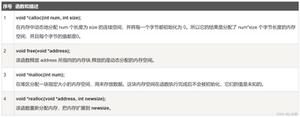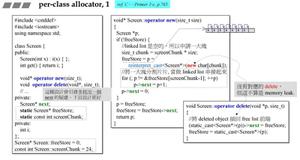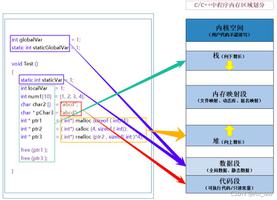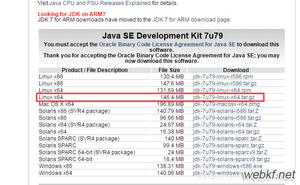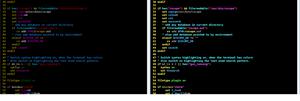Linux3.14.12内存管理笔记【伙伴管理算法(4)】

此处承接前面未深入分析的页面释放部分,主要详细分析伙伴管理算法中页面释放的实现。页面释放的函数入口是__free_page(),其实则是一个宏定义。
具体实现:
【file:/include/linux/gfp.h】#define __free_page(page) __free_pages((page), 0)
而__free_pages()的实现:
【file:/mm/page_alloc.c】void __free_pages(struct page *page, unsigned int order)
{
if (put_page_testzero(page)) {
if (order == 0)
free_hot_cold_page(page, 0);
else
__free_pages_ok(page, order);
}
}
其中put_page_testzero()是对page结构的_count引用计数做原子减及测试,用于检查内存页面是否仍被使用,如果不再使用,则进行释放。其中order表示页面数量,如果释放的是单页,则会调用free_hot_cold_page()将页面释放至per-cpu page缓存中,而不是伙伴管理算法;真正的释放至伙伴管理算法的是__free_pages_ok(),同时也是用于多个页面释放的情况。
此处接着则由free_hot_cold_page()开始分析:
【file:/mm/page_alloc.c】/*
* Free a 0-order page
* cold == 1 ? free a cold page : free a hot page
*/
void free_hot_cold_page(struct page *page, int cold)
{
struct zone *zone = page_zone(page);
struct per_cpu_pages *pcp;
unsigned long flags;
int migratetype;
if (!free_pages_prepare(page, 0))
return;
migratetype = get_pageblock_migratetype(page);
set_freepage_migratetype(page, migratetype);
local_irq_save(flags);
__count_vm_event(PGFREE);
/*
* We only track unmovable, reclaimable and movable on pcp lists.
* Free ISOLATE pages back to the allocator because they are being
* offlined but treat RESERVE as movable pages so we can get those
* areas back if necessary. Otherwise, we may have to free
* excessively into the page allocator
*/
if (migratetype >= MIGRATE_PCPTYPES) {
if (unlikely(is_migrate_isolate(migratetype))) {
free_one_page(zone, page, 0, migratetype);
goto out;
}
migratetype = MIGRATE_MOVABLE;
}
pcp = &this_cpu_ptr(zone->pageset)->pcp;
if (cold)
list_add_tail(&page->lru, &pcp->lists[migratetype]);
else
list_add(&page->lru, &pcp->lists[migratetype]);
pcp->count++;
if (pcp->count >= pcp->high) {
unsigned long batch = ACCESS_ONCE(pcp->batch);
free_pcppages_bulk(zone, batch, pcp);
pcp->count -= batch;
}
out:
local_irq_restore(flags);
}
先看一下free_pages_prepare()的实现:
【file:/mm/page_alloc.c】static bool free_pages_prepare(struct page *page, unsigned int order)
{
int i;
int bad = 0;
trace_mm_page_free(page, order);
kmemcheck_free_shadow(page, order);
if (PageAnon(page))
page->mapping = NULL;
for (i = 0; i < (1 << order); i++)
bad += free_pages_check(page + i);
if (bad)
return false;
if (!PageHighMem(page)) {
debug_check_no_locks_freed(page_address(page),
PAGE_SIZE << order);
debug_check_no_obj_freed(page_address(page),
PAGE_SIZE << order);
}
arch_free_page(page, order);
kernel_map_pages(page, 1 << order, 0);
return true;
}
其中trace_mm_page_free()用于trace追踪机制;而kmemcheck_free_shadow()用于内存检测工具kmemcheck,如果未定义CONFIG_KMEMCHECK的情况下,它是一个空函数。接着后面的PageAnon()等都是用于检查页面状态的情况,以判断页面是否允许释放,避免错误释放页面。由此可知该函数主要作用是检查和调试。
接着回到free_hot_cold_page()函数中,get_pageblock_migratetype()和set_freepage_migratetype()分别是获取和设置页面的迁移类型,即设置到page->index;local_irq_save()和末尾的local_irq_restore()则用于保存恢复中断请求标识。
if (migratetype >= MIGRATE_PCPTYPES) { if (unlikely(is_migrate_isolate(migratetype))) {
free_one_page(zone, page, 0, migratetype);
goto out;
}
migratetype = MIGRATE_MOVABLE;
}
这里面的MIGRATE_PCPTYPES用来表示每CPU页框高速缓存的数据结构中的链表的迁移类型数目,如果某个页面类型大于MIGRATE_PCPTYPES则表示其可挂到可移动列表中,如果迁移类型是MIGRATE_ISOLATE则直接将该其释放到伙伴管理算法中。
末尾部分:
pcp = &this_cpu_ptr(zone->pageset)->pcp; if (cold)
list_add_tail(&page->lru, &pcp->lists[migratetype]);
else
list_add(&page->lru, &pcp->lists[migratetype]);
pcp->count++;
if (pcp->count >= pcp->high) {
unsigned long batch = ACCESS_ONCE(pcp->batch);
free_pcppages_bulk(zone, batch, pcp);
pcp->count -= batch;
}
其中pcp表示内存管理区的每CPU管理结构,cold表示冷热页面,如果是冷页就将其挂接到对应迁移类型的链表尾,而若是热页则挂接到对应迁移类型的链表头。其中if (pcp->count >= pcp->high)判断值得注意,其用于如果释放的页面超过了每CPU缓存的最大页面数时,则将其批量释放至伙伴管理算法中,其中批量数为pcp->batch。
具体分析一下释放至伙伴管理算法的实现free_pcppages_bulk():
【file:/mm/page_alloc.c】/*
* Frees a number of pages from the PCP lists
* Assumes all pages on list are in same zone, and of same order.
* count is the number of pages to free.
*
* If the zone was previously in an "all pages pinned" state then look to
* see if this freeing clears that state.
*
* And clear the zone's pages_scanned counter, to hold off the "all pages are
* pinned" detection logic.
*/
static void free_pcppages_bulk(struct zone *zone, int count,
struct per_cpu_pages *pcp)
{
int migratetype = 0;
int batch_free = 0;
int to_free = count;
spin_lock(&zone->lock);
zone->pages_scanned = 0;
while (to_free) {
struct page *page;
struct list_head *list;
/*
* Remove pages from lists in a round-robin fashion. A
* batch_free count is maintained that is incremented when an
* empty list is encountered. This is so more pages are freed
* off fuller lists instead of spinning excessively around empty
* lists
*/
do {
batch_free++;
if (++migratetype == MIGRATE_PCPTYPES)
migratetype = 0;
list = &pcp->lists[migratetype];
} while (list_empty(list));
/* This is the only non-empty list. Free them all. */
if (batch_free == MIGRATE_PCPTYPES)
batch_free = to_free;
do {
int mt; /* migratetype of the to-be-freed page */
page = list_entry(list->prev, struct page, lru);
/* must delete as __free_one_page list manipulates */
list_del(&page->lru);
mt = get_freepage_migratetype(page);
/* MIGRATE_MOVABLE list may include MIGRATE_RESERVEs */
__free_one_page(page, zone, 0, mt);
trace_mm_page_pcpu_drain(page, 0, mt);
if (likely(!is_migrate_isolate_page(page))) {
__mod_zone_page_state(zone, NR_FREE_PAGES, 1);
if (is_migrate_cma(mt))
__mod_zone_page_state(zone, NR_FREE_CMA_PAGES, 1);
}
} while (--to_free && --batch_free && !list_empty(list));
}
spin_unlock(&zone->lock);
}
里面while大循环用于计数释放指定批量数的页面。其中释放方式是先自MIGRATE_UNMOVABLE迁移类型起(止于MIGRATE_PCPTYPES迁移类型),遍历各个链表统计其链表中页面数:
do { batch_free++;
if (++migratetype == MIGRATE_PCPTYPES)
migratetype = 0;
list = &pcp->lists[migratetype];
} while (list_empty(list));
如果只有MIGRATE_PCPTYPES迁移类型的链表为非空链表,则全部页面将从该链表中释放。
后面的do{}while()里面,其先将页面从lru链表中去除,然后获取页面的迁移类型,通过__free_one_page()释放页面,最后使用__mod_zone_page_state()修改管理区的状态值。
着重分析一下__free_one_page()的实现:
【file:/mm/page_alloc.c】/*
* Freeing function for a buddy system allocator.
*
* The concept of a buddy system is to maintain direct-mapped table
* (containing bit values) for memory blocks of various "orders".
* The bottom level table contains the map for the smallest allocatable
* units of memory (here, pages), and each level above it describes
* pairs of units from the levels below, hence, "buddies".
* At a high level, all that happens here is marking the table entry
* at the bottom level available, and propagating the changes upward
* as necessary, plus some accounting needed to play nicely with other
* parts of the VM system.
* At each level, we keep a list of pages, which are heads of continuous
* free pages of length of (1 << order) and marked with _mapcount
* PAGE_BUDDY_MAPCOUNT_VALUE. Page's order is recorded in page_private(page)
* field.
* So when we are allocating or freeing one, we can derive the state of the
* other. That is, if we allocate a small block, and both were
* free, the remainder of the region must be split into blocks.
* If a block is freed, and its buddy is also free, then this
* triggers coalescing into a block of larger size.
*
* -- nyc
*/
static inline void __free_one_page(struct page *page,
struct zone *zone, unsigned int order,
int migratetype)
{
unsigned long page_idx;
unsigned long combined_idx;
unsigned long uninitialized_var(buddy_idx);
struct page *buddy;
VM_BUG_ON(!zone_is_initialized(zone));
if (unlikely(PageCompound(page)))
if (unlikely(destroy_compound_page(page, order)))
return;
VM_BUG_ON(migratetype == -1);
page_idx = page_to_pfn(page) & ((1 << MAX_ORDER) - 1);
VM_BUG_ON_PAGE(page_idx & ((1 << order) - 1), page);
VM_BUG_ON_PAGE(bad_range(zone, page), page);
while (order < MAX_ORDER-1) {
buddy_idx = __find_buddy_index(page_idx, order);
buddy = page + (buddy_idx - page_idx);
if (!page_is_buddy(page, buddy, order))
break;
/*
* Our buddy is free or it is CONFIG_DEBUG_PAGEALLOC guard page,
* merge with it and move up one order.
*/
if (page_is_guard(buddy)) {
clear_page_guard_flag(buddy);
set_page_private(page, 0);
__mod_zone_freepage_state(zone, 1 << order,
migratetype);
} else {
list_del(&buddy->lru);
zone->free_area[order].nr_free--;
rmv_page_order(buddy);
}
combined_idx = buddy_idx & page_idx;
page = page + (combined_idx - page_idx);
page_idx = combined_idx;
order++;
}
set_page_order(page, order);
/*
* If this is not the largest possible page, check if the buddy
* of the next-highest order is free. If it is, it's possible
* that pages are being freed that will coalesce soon. In case,
* that is happening, add the free page to the tail of the list
* so it's less likely to be used soon and more likely to be merged
* as a higher order page
*/
if ((order < MAX_ORDER-2) && pfn_valid_within(page_to_pfn(buddy))) {
struct page *higher_page, *higher_buddy;
combined_idx = buddy_idx & page_idx;
higher_page = page + (combined_idx - page_idx);
buddy_idx = __find_buddy_index(combined_idx, order + 1);
higher_buddy = higher_page + (buddy_idx - combined_idx);
if (page_is_buddy(higher_page, higher_buddy, order + 1)) {
list_add_tail(&page->lru,
&zone->free_area[order].free_list[migratetype]);
goto out;
}
}
list_add(&page->lru, &zone->free_area[order].free_list[migratetype]);
out:
zone->free_area[order].nr_free++;
}
于while (order < MAX_ORDER-1)前面主要是对释放的页面进行检查校验操作。而while循环内,通过__find_buddy_index()获取与当前释放的页面处于同一阶的伙伴页面索引值,同时藉此索引值计算出伙伴页面地址,并做伙伴页面检查以确定其是否可以合并,若否则退出;接着if (page_is_guard(buddy))用于对页面的debug_flags成员做检查,由于未配置CONFIG_DEBUG_PAGEALLOC,page_is_guard()固定返回false;则剩下的操作主要就是将页面从分配链中摘除,同时将页面合并并将其处于的阶提升一级。
退出while循环后,通过set_page_order()设置页面最终可合并成为的管理阶。最后判断当前合并的页面是否为最大阶,否则将页面放至伙伴管理链表的末尾,避免其过早被分配,得以机会进一步与高阶页面进行合并。末了,将最后的挂入的阶的空闲计数加1。
至此伙伴管理算法的页面释放完毕。
而__free_pages_ok()的页面释放实现调用栈则是:
__free_pages_ok()—>free_one_page()
—>__free_one_page()
殊途同归,最终还是__free_one_page()来释放,具体的过程就不再仔细分析了。
以上是 Linux3.14.12内存管理笔记【伙伴管理算法(4)】 的全部内容, 来源链接: utcz.com/z/511832.html

